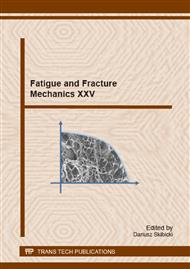p.157
p.167
p.175
p.181
p.187
p.192
p.198
p.204
p.210
The Influence of Modelling Material Zones on Strains and Stresses at Weld Toe Notch
Abstract:
The latest development in the field of welding technology enabled prefabrication of thinwalled sandwich structures in an industrial scale. Sandwich structures fabricated of steel, or aluminium alloy plates and stiffeners are welded with the use of hipower CO2 lasers. Strength analysis of such structures with the use of finite element method needs proper material modelling. In this paper the material model of steel sandwich panel tee-joint is analysed. The influence of including different material zones on strains and stresses at the weld notch area is presented. The analysis shows that material changes outside the weld notch area do not influence the results of strains and stresses. The impact of the geometrical notch is very local and it does not interfere with material property changes at neighbouring weld zones. For the purpose of determination of maximum values of stresses and strains at weld toe notch, the analysed laser weld can be modelled with the use of one material property for all weld zones.
Info:
Periodical:
Pages:
187-191
Citation:
Online since:
November 2014
Authors:
Keywords:
Price:
Сopyright:
© 2015 Trans Tech Publications Ltd. All Rights Reserved
Share:
Citation:


